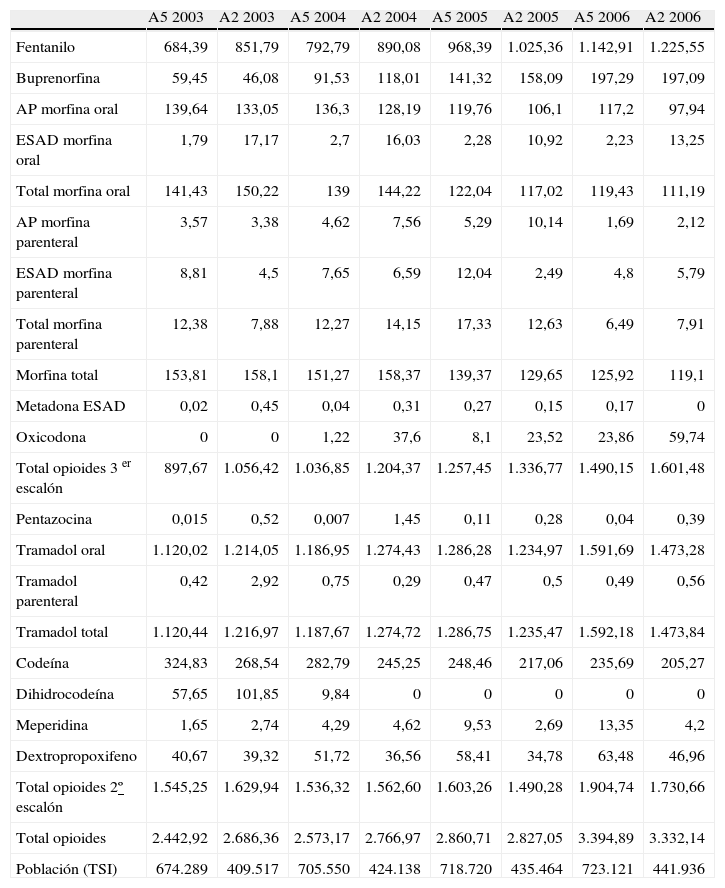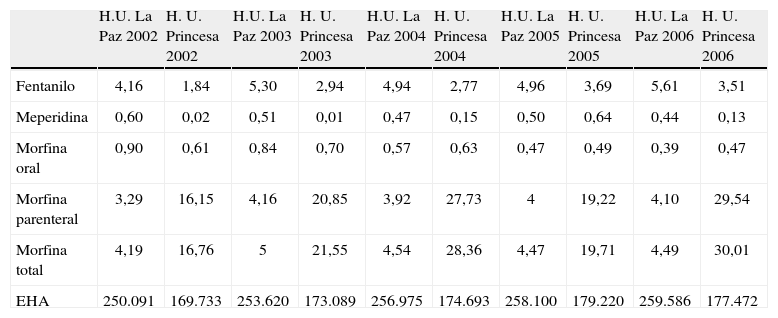Describir la evolución de la prescripción de opiáceos desde 2002 a 2006 en las áreas 2 y 5 de Atención Primaria de la Comunidad de Madrid y sus hospitales de referencia (Hospitales Universitarios de la Princesa y la Paz).
Material y métodoEstudio observacional retrospectivo de prescripciones realizadas mediante el cálculo de dosis por habitante y día.
ResultadosEn Atención Primaria, el opiáceo más prescrito del tercer escalón analgésico de la Organización Mundial de la Salud es el fentanilo transdérmico (78,39% del total en 2006 en el área 2 y 76,69% en el área 5), seguido por la buprenofina (12,30% y 13,23%) y la morfina (6,94% y 8,45%). En cuanto al segundo escalón, el tramadol es el opiáceo más prescrito con un 85,12% y un 83,56% del consumo total.
Observamos un crecimiento del consumo del tercer escalón desde una dosis por habitante y día 897,67 en 2003 en el área 5 y 1.056,42 en el área 2, hasta 1.490,15 y 1.601,48, respectivamente, en 2006 y del segundo escalón desde 1.545,25 y 1.629,94 en 2003 hasta 1.904,70 y 1.730,66 en ambas áreas en 2006. En los hospitales analizados se aprecia una progresión similar con un incremento gradual en la utilización del fentanilo y una tendencia a la reducción del consumo de morfina.
ConclusionesNuestros datos reflejan el aumento del consumo de opiáceos a pesar del descenso de la morfina. Es destacable que el fentanilo transdérmico es el mayor opiáceo prescrito.
Describe the evolution of prescription opioids from 2002 to 2006 in Primary Health Care Area 2 and 5 in the Madrid Community and its referral hospitals (University Hospitals of la Princesa and La Paz).
Materials and methodsA retrospective observational study of prescriptions made by calculating defined daily doses per million inhabitants.
ResultsIn Primary Care, transdermal fentanyl (78.39% of the total in 2006 in area 2 and 76.69% in the area 5) is the opioid prescribed most on the third step on the WHO analgesic ladder. This is followed by buprenofin (12.30% and 13.23%) and morphine (6.94% and 8.45%). As for the second step, tramadol is the most prescribed opioid with 85.12% and 83.56% of total consumption. We see a growth in consumption in the third step that goes from a defined daily doses per one million inhabitants of 897.67 in 2003 in area 5 and 1056.42 in area 2 to 1490.15 and 1601.48, respectively in 2006 and the second step goes from 1545.25 and 1629.94 in 2003 to 1904.70 and 1730.66 in both areas in 2006. In the hospitals analyzed, there is a similar progression, with a gradual increase in the use of fentanyl and a trend towards reduction in the consumption of morphine.
ConclusionsOur data reflect the increase in consumption of opioids, despite declining morphine. It is noteworthy that transdermal fentanyl is the opioid prescribed most.
Artículo
Diríjase desde aquí a la web de la >>>FESEMI<<< e inicie sesión mediante el formulario que se encuentra en la barra superior, pulsando sobre el candado.

Una vez autentificado, en la misma web de FESEMI, en el menú superior, elija la opción deseada.

>>>FESEMI<<<











